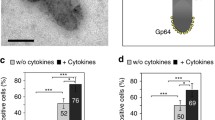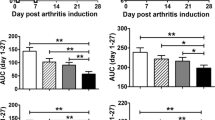Abstract
The objective of this study is to construct and identify an inducible lentiviral vector containing improved tet-on system and FasL gene and observe its effects on pristane-induced arthritis (PIA). FasL gene was amplified from the spleen of Lewis rats by RT-PCR. The tet-on system was improved with insertion of a chicken chromatin insulator (cHS4) element and an rtTA-dependent, tet-responsive element containing modifications of the tetO sequence (TRE-tight1). Pro-apoptosis effect of the vector pTREFasLcHS4V16 on synovial cells was evaluated by flow cytometer in vitro. Anti-arthritis effects of the vector on PIA after intra-articular injection were observed by clinical evaluation and joint histology. Cytokines in synovial tissue were measured by ELISA. The recombinant inducible lentiviral vector pTREFasLcHS4V16 was successfully constructed. The expression response and the pro-apoptosis effects of the vector were doxycycline dose-dependent. The vector injected intra-articularly attenuated the severity of PIA and decreased the level of cytokines in inflamed joints. pTREFasLcHS4V16 with an improved tet-on system can precisely regulate the expression of FasL gene and apoptosis. Anti-arthritis effects were observed after intra-articular injection of the inducible vector.




Similar content being viewed by others
References
Liu H, Pope RM (2004) Apoptosis in rheumatoid arthritis: friend or foe. Rheum Dis Clin North Am 30:603–625
Pope RM (2002) Apoptosis as a therapeutic tool in rheumatoid arthritis. Nat Rev Immunol 2:527–535
Peng SL (2006) Fas (CD95)-related apoptosis and rheumatoid arthritis. Rheumatology (Oxford) 45:26–30
Asahara H, Hasumuna T, Kobata T, Yagita H, Okumura K, Inoue H, Gay S, Sumida T, Nishioka K (1996) Expression of Fas antigen and Fas ligand in the rheumatoid synovial tissue. Clin Immunol Immunopathol 81:27–34
Pundt N, Peters MA, Wunrau C, Strietholt S, Fehrmann C, Neugebauer K, Seyfert C, van Valen F, Pap T, Meinecke I (2009) Susceptibility of rheumatoid arthritis synovial fibroblasts to FasL- and TRAIL-induced apoptosis is cell cycle-dependent. Arthritis Res Ther 11:R16
Zhang H, Gao G, Clayburne G, Schumacher HR (2005) Elimination of rheumatoid synovium in situ using a Fas ligand ‘gene scalpel’. Arthritis Res Ther 7:R1235–R1243
Okamoto K, Asahara H, Kobayashi T, Matsuno H, Hasunuma T, Kobata T, Sumida T, Nishioka K (1998) Induction of apoptosis in the rheumatoid synovium by Fas ligand gene transfer. Gene Ther 5:331–338
Adriaansen J, Vervoordeldonk MJ, Tak PP (2006) Gene therapy as a therapeutic approach for the treatment of rheumatoid arthritis: innovative vectors and therapeutic genes. Rheumatology (Oxford) 45:656–668
Weber W, Fussenegger M (2006) Pharmacologic transgene control systems for gene therapy. J Gene Med 8:535–556
Osti D, Marras E, Ceriani I, Grassini G, Rubino T, Vigano D, Parolaro D, Perletti G (2006) Comparative analysis of molecular strategies attenuating positional effects in lentiviral vectors carrying multiple genes. J Virol Methods 136:93–101
Apparailly F, Millet V, Noel D, Jacquet C, Sany J, Jorgensen C (2002) Tetracycline-inducible interleukin-10 gene transfer mediated by an adeno-associated virus: application to experimental arthritis. Hum Gene Ther 13:1179–1188
Joosten LA, Helsen MM, Saxne T, van De Loo FA, Heinegard D, van Den Berg WB (1999) IL-1 Alpha beta blockade prevents cartilage and bone destruction in murine type II collagen-induced arthritis, whereas TNF-alpha blockade only ameliorates joint inflammation. J Immunol 163:5049–5055
Tian X, Wang G, Xu Y, Wang P, Chen S, Yang H, Gao F, Xu A, Cao F, Jin X, Manyande A, Tian Y (2009) An improved tet-on system for gene expression in neurons delivered by a single lentiviral vector. Hum Gene Ther 20:113–123
Liu Z, Xu X, Hsu HC, Tousson A, Yang PA, Wu Q, Liu C, Yu S, Zhang HG, Mountz JD (2003) CII-DC-AdTRAIL cell gene therapy inhibits infiltration of CII-reactive T cells and CII-induced arthritis. J Clin Invest 112:1332–1341
Agha-Mohammadi S, O’Malley M, Etemad A, Wang Z, Xiao X, Lotze MT (2004) Second-generation tetracycline-regulatable promoter: repositioned tet operator elements optimize transactivator synergy while shorter minimal promoter offers tight basal leakiness. J Gene Med 6:817–828
Rang A, Will H (2000) The tetracycline-responsive promoter contains functional interferon-inducible response elements. Nucleic Acids Res 28:1120–1125
Villemure JF, Savard N, Belmaaza A (2001) Promoter suppression in cultured mammalian cells can be blocked by the chicken beta-globin chromatin insulator 5′HS4 and matrix/scaffold attachment regions. J Mol Biol 312:963–974
Zhao H, Dean A (2005) Organizing the genome: enhancers and insulators. Biochem Cell Biol 83:516–524
Vingsbo C, Sahlstrand P, Brun JG, Jonsson R, Saxne T, Holmdahl R (1996) Pristane-induced arthritis in rats: a new model for rheumatoid arthritis with a chronic disease course influenced by both major histocompatibility complex and non-major histocompatibility complex genes. Am J Pathol 149:1675–1683
Holmdahl R, Lorentzen JC, Lu S, Olofsson P, Wester L, Holmberg J, Pettersson U (2001) Arthritis induced in rats with nonimmunogenic adjuvants as models for rheumatoid arthritis. Immunol Rev 184:184–202
Perlman H, Pagliari LJ, Georganas C, Mano T, Walsh K, Pope RM (1999) Flice-inhibitory protein expression during macrophage differentiation confers resistance to FAS-mediated apoptosis. J Exp Med 190:1679–1688
Acknowledgments
This study was supported by a grant from National Natural Science Foundation of China (No. 30571789).
Conflict of interest
The authors declare that they have no conflict of interest.
Author information
Authors and Affiliations
Corresponding author
Additional information
Qingyu Shi and Xuebi Tian contributed equally to this work.
Rights and permissions
About this article
Cite this article
Shi, Q., Tian, X., Zhao, Y. et al. Anti-arthritic effects of FasL gene transferred intra-articularly by an inducible lentiviral vector containing improved tet-on system. Rheumatol Int 34, 51–57 (2014). https://doi.org/10.1007/s00296-011-2002-z
Received:
Accepted:
Published:
Issue Date:
DOI: https://doi.org/10.1007/s00296-011-2002-z




